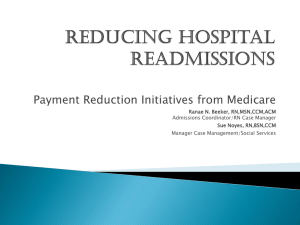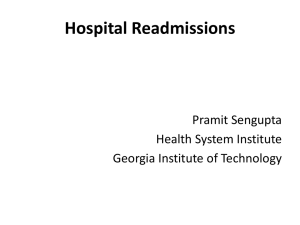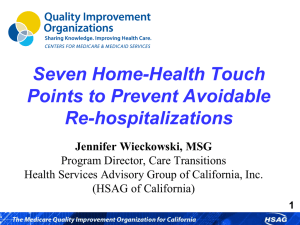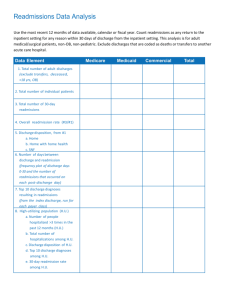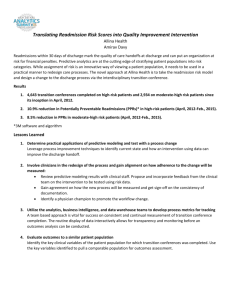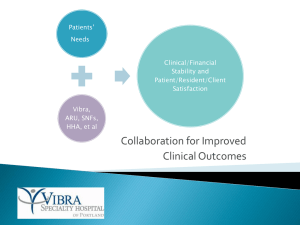In the Literature
advertisement
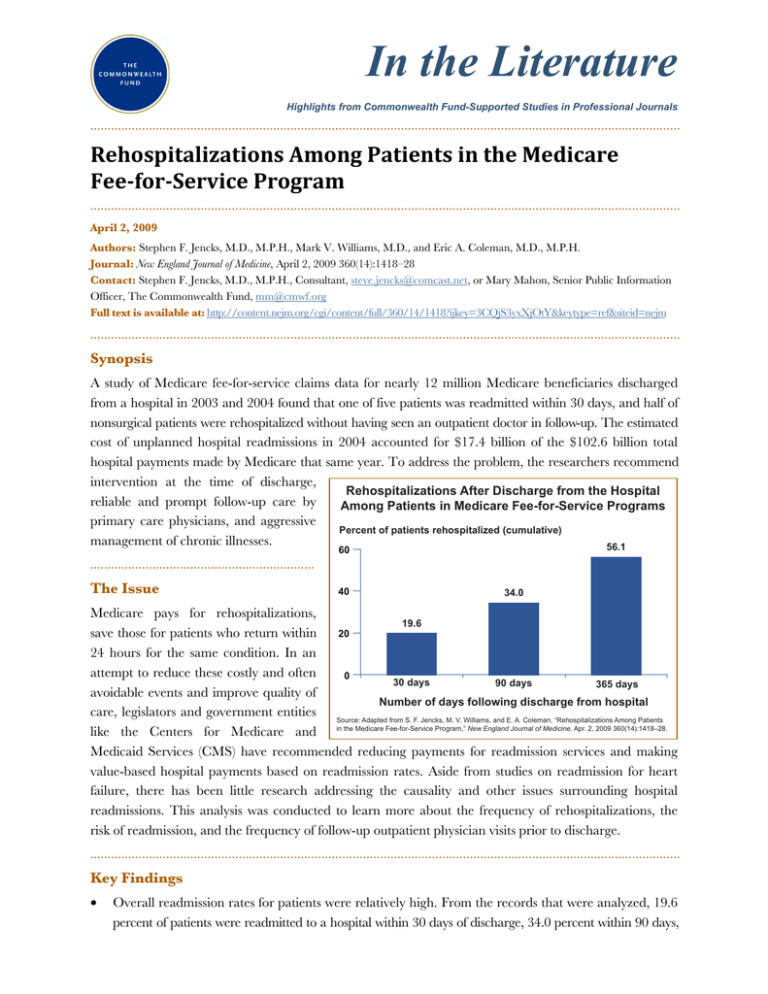
In the Literature Highlights from Commonwealth Fund-Supported Studies in Professional Journals ........................................................................................................................................................................... Rehospitalizations Among Patients in the Medicare Fee­for­Service Program ........................................................................................................................................................................... April 2, 2009 Authors: Stephen F. Jencks, M.D., M.P.H., Mark V. Williams, M.D., and Eric A. Coleman, M.D., M.P.H. Journal: New England Journal of Medicine, April 2, 2009 360(14):1418–28 Contact: Stephen F. Jencks, M.D., M.P.H., Consultant, steve.jencks@comcast.net, or Mary Mahon, Senior Public Information Officer, The Commonwealth Fund, mm@cmwf.org Full text is available at: http://content.nejm.org/cgi/content/full/360/14/1418?ijkey=3CQjS3yxXjOtY&keytype=ref&siteid=nejm ........................................................................................................................................................................... Synopsis A study of Medicare fee-for-service claims data for nearly 12 million Medicare beneficiaries discharged from a hospital in 2003 and 2004 found that one of five patients was readmitted within 30 days, and half of nonsurgical patients were rehospitalized without having seen an outpatient doctor in follow-up. The estimated cost of unplanned hospital readmissions in 2004 accounted for $17.4 billion of the $102.6 billion total hospital payments made by Medicare that same year. To address the problem, the researchers recommend intervention at the time of discharge, Rehospitalizations After Discharge from the Hospital reliable and prompt follow-up care by Among Patients in Medicare Fee-for-Service Programs primary care physicians, and aggressive Percent of patients rehospitalized (cumulative) management of chronic illnesses. 56.1 ................................................................. The Issue 60 40 34.0 Medicare pays for rehospitalizations, 19.6 20 save those for patients who return within 24 hours for the same condition. In an attempt to reduce these costly and often 0 30 days 90 days 365 days avoidable events and improve quality of Number of days following discharge from hospital care, legislators and government entities Source: Adapted from S. F. Jencks, M. V. Williams, and E. A. Coleman, “Rehospitalizations Among Patients like the Centers for Medicare and in the Medicare Fee-for-Service Program,” New England Journal of Medicine, Apr. 2, 2009 360(14):1418–28. Medicaid Services (CMS) have recommended reducing payments for readmission services and making value-based hospital payments based on readmission rates. Aside from studies on readmission for heart failure, there has been little research addressing the causality and other issues surrounding hospital readmissions. This analysis was conducted to learn more about the frequency of rehospitalizations, the risk of readmission, and the frequency of follow-up outpatient physician visits prior to discharge. ........................................................................................................................................................................... Key Findings • Overall readmission rates for patients were relatively high. From the records that were analyzed, 19.6 percent of patients were readmitted to a hospital within 30 days of discharge, 34.0 percent within 90 days, and 56.1 percent within a year. Of those patients discharged with medical conditions, 68.9 percent were rehospitalized or died within one year after discharge; of those discharged after surgical procedures, the rate was 53.0 percent. • For half of patients readmitted within 30 days, there was no bill for a physician visit during that time. And for patients who returned after a surgery was performed, 70 percent were admitted for a medical condition, such as pneumonia or a urinary tract infection. • Readmission rates varied greatly from state to state, with the highest five states seeing rates 45 percent higher than the lowest five. • The five most common medical conditions for which hospital readmissions occur are: heart failure, pneumonia, chronic obstructive pulmonary disease, psychoses, and gastrointestinal problems. The five most common surgical procedures are: cardiac stent placement, major hip or knee surgery, vascular surgery, major bowel surgery, and other hip or femur surgery. • The reason for the hospitalization and the length of stay contributed more to readmission than did demographic factors such as age, race, or presence of disability. ........................................................................................................................................................................... Addressing the Problem A number of interventions at the time of discharge that have been shown to decrease readmissions should be used more widely, the researchers said. Supportive palliative care can also reduce rehospitalization and increase patient satisfaction. Both medical and surgical patients would also likely benefit if their hospital physicians increased efforts to coordinate prompt and reliable follow-up care with primary care physicians. ................................................................................................................ About the Study “Although the rehospitalization rate is often presented as a measure of the performance of hospitals, it may also be a useful indicator of the performance of our health care system.” The authors used data from the Medicare Provider Analysis and Review (MEDPAR) file covering the period October 1, 2003, to December 31, 2004. Data for follow-up visits was compiled from the national sample for 2003 in the CMS Chronic Condition Data Warehouse. A total of 13,062,937 patients enrolled in Medicare’s fee-for-service program were discharged during the study time period. More than 500,000 of these patients died and almost 700,000 ended up in other acute-care settings, leaving a total of 11,855,702 at risk for hospital readmission. ........................................................................................................................................................................... The Bottom Line Hospital readmissions are frequent and costly events which researchers suggest can be reduced by systemic changes to the health care system, including improved transition planning, quick follow-up care, and persistent treatment of chronic illnesses. ........................................................................................................................................................................... Citation S. F. Jencks, M. V. Williams, and E. A. Coleman, “Rehospitalizations Among Patients in the Medicare Fee-for-Service Program,” New England Journal of Medicine, Apr. 2, 2009 360(14):1418–28. ........................................................................................................................................................................... This summary was prepared by Tammy Worth.
